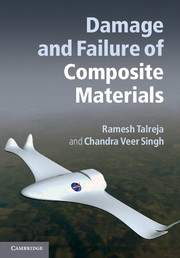Book contents
- Frontmatter
- Contents
- Preface
- 1 Durability assessment of composite structures
- 2 Review of mechanics of composite materials
- 3 Damage in composite materials
- 4 Micro-damage mechanics
- 5 Macro-damage mechanics
- 6 Damage progression
- 7 Damage mechanisms and fatigue-life diagrams
- 8 Future directions
- Author index
- Subject index
- References
1 - Durability assessment of composite structures
Published online by Cambridge University Press: 05 July 2012
- Frontmatter
- Contents
- Preface
- 1 Durability assessment of composite structures
- 2 Review of mechanics of composite materials
- 3 Damage in composite materials
- 4 Micro-damage mechanics
- 5 Macro-damage mechanics
- 6 Damage progression
- 7 Damage mechanisms and fatigue-life diagrams
- 8 Future directions
- Author index
- Subject index
- References
Summary
Introduction
Composite structures for mechanical and aerospace applications are designed to retain structural integrity and remain durable for the intended service life. Since the early 1970s important advances have been made in characterizing and modeling the underlying mechanical behavior and developing tools and methodologies for predicting the fracture and fatigue of composite materials. This book provides an exposition of the concepts and analyses related to this area and presents recent results. The next chapters treat damage in composite materials as observed by a variety of techniques, followed by modeling at the micro and macro levels. Fatigue is treated separately because of its particular complexities that require systematic interpretation schemes developed for the purpose. A chapter is added in the beginning to provide convenient access to the mechanics concepts needed for the modeling analyses in later chapters.
Here we present an overview of the durability assessment process for composite structures. Figure 1.1 depicts the connectivity and flow of the elements of this process. To begin, one usually conducts stress analysis of the component using the “initial” constitutive behavior of the composite along with the service loading on the component as input. In contrast to monolithic materials, such as metals, the constitutive behavior of a composite can change due to damage incurred in service. The stress analysis combined with prior experience allows identifying critical sites (“hot spots”) in the component that are prone to be the sites of failure. Further examination of these sites in terms of the local stress/strain/temperature excursions combined with the composite material composition at those sites helps to identify the possible mechanisms of damage that can result. Examples of such mechanisms are microcracking of the matrix, delamination (separation of layers at interfaces), aging (of the polymer matrix), etc.
- Type
- Chapter
- Information
- Damage and Failure of Composite Materials , pp. 1 - 8Publisher: Cambridge University PressPrint publication year: 2012



